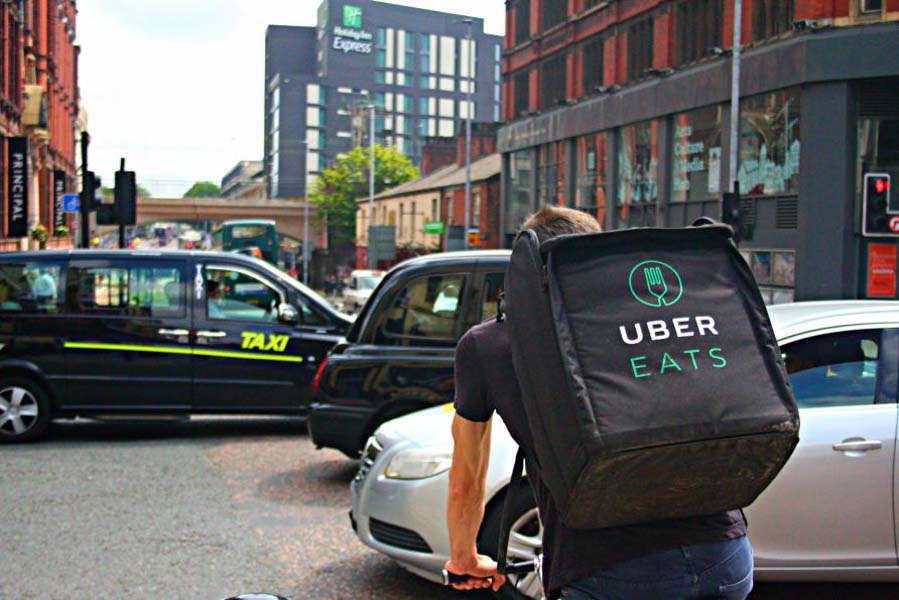5 challenges that will make or break the gig economy
By Andrew Trounson
The gig economy, or platform work, has emerged from nowhere courtesy of the mobile technology boom, but there are question marks over whether it heralds a new future of work
For something so small, the gig-economy makes a lot of noise.
These days, Uber drivers and food couriers in our cities are just an app-click away. It’s not surprising then that there’s widespread speculation over whether these new platforms give us a glimpse into the future of work, accelerating the already-growing trend towards more insecure, short-term jobs.
But the reality is that, right now, few people are opting for this kind of work and there are serious questions about its sustainability, says Dr Josh Healy, senior research fellow at the University of Melbourne’s Centre for Workplace Leadership.

He points out the Grattan Institute estimates that less than 0.5 per cent of adult Australians work on peer-to-peer platforms, like Uber or Deliveroo, more than once a month, and US bank data from 2015 suggest that just 0.4 per cent of Americans did paid work on a platform.
“The evidence so far is a bit contrary to the hype we hear. If we take a step back and look at the data, it is still a very small sliver of the workforce,” says Dr Healy.
And it may stay that way.
In a new paper published in Labour and Industry, Dr Healy and his University of Melbourne colleagues Mr Daniel Nicholson and Dr Andreas Pekarek, set out the five key challenges now standing in the way of gig-platforms becoming anything like the future of work.
Dr Healy says it is no coincidence that the growth of gig-platforms has come at a time when advanced economies are still struggling to fully recover from the Global Financial Crisis that continues to weigh on labour markets and wages.

“We have a pretty slack labour market at the moment and that is a situation that suits these platform companies well, as there are many people looking to pick up some work,” says Dr Healy. “But as soon as things improve that ready supply of workers could dry up.
“At that point, the business models of these gig platforms could look a bit shaky because they don’t offer ongoing employment, they don’t offer training, and workers are very much left on their own.
“That could be very problematic if there are better options out there in the labour market.”
Last year, a UK employment tribunal ruled that Uber drivers weren’t independent contractors but employees and therefore entitled to be treated as such.
“The notion that Uber in London is a mosaic of 30,000 small businesses linked by a common platform is in our mind faintly ridiculous,” the Employment Tribunals said in its ruling, which was upheld this month, despite Uber’s appeal. Uber is now planning to challenge the ruling in court.
Dr Healy and his co-authors argue that regulation like this, or re-regulation, aimed at extending normal employment conditions to gig-workers represents a clear threat to the profitability of these platforms.
“Future rulings could substantially harm the arms-length, low-cost labour strategies on which many platforms rely, by requiring them to honour regular employment obligations, such as in Australia paid leave and superannuation,” the researchers write.
One of the ongoing debates over gig-platforms is whether they represent a potentially new and easier way for people to break into employment by securing experience, or whether such work is simply an employment cul-de-sac. As yet, there is scant evidence either way.

“The gig-economy might have a role in helping new workers to navigate the challenging initial phases of their working life, if it operates as a bridge,” they say.
But they warn the alternative is that it acts instead as a “trap” isolating workers from the mainstream and sending negative signals to potential employers.
“Only longitudinal data can sort out which of these competing propositions is more accurate. This could be something like an augmented version of the long-running Household, Income and Labour Dynamics in Australia survey (HILDA) that focuses on people’s incomes and work trajectories but could include some new tailored questions.”
So far, the big growth in the gig-economy has been in relatively low-skilled work like driving and delivering, which reinforces perceptions that such work is no more than what Dr Healy calls a “stop gap” option for people topping up income or looking for permanent employment.
If the platform model is to become more mainstream, it will have to successfully expand into higher skilled work, says Dr Healy. There are already moves in this area with platform businesses emerging in accounting, consulting, legal work, and even disability care.
But Dr Healy is sceptical. While people with especially high-demand skills may benefit from a gig economy that allows them to set high prices on their work, he believes most people will be uncomfortable with the insecurity that goes with the gig-economy and its lack of skills development.
“There is nothing going on in the gig economy that suggests to me that it is something that would be very appealing to the mainstream workforce,” says Dr Healy.
The success of the likes of Uber raises the possibility of workers banding together to create cooperatively-owned platforms run in the interests of workers rather than the app developers. While structures like this could become more sustainable because they are more attractive to workers, Dr Healy warns that it will be difficult for such cooperatives to break into markets where app developers have been quick to establish a dominant market share.
“The cooperatively-owned platform makes sense as a way for workers to keep some of the surplus profits rather than have it go to Silicon Valley, but they will struggle to get noticed when the market is already dominated by an established app that everyone is using.”

For Dr Healy, the potential for gig-platforms to revolutionise work is more hype than reality. But he says they are an important development in the long-term trend toward more insecure work. And in that sense, he says, the emergence of gig-platforms underscores the need for more policy work on how labour laws can be fairly applied across the many different types of work people are now doing.
This is telling in an environment like Australia’s, where 27 per cent of the private-sector workforce is already casualised.
“We have opened up a whole plethora of new variants on work that in one way or another sit outside the boundaries of existing labour laws.
“It may be that we need to start looking at broadening the scope of regulation to cover people’s actual work, not their employment type.”
This article was first published on Pursuit. Read the original article.